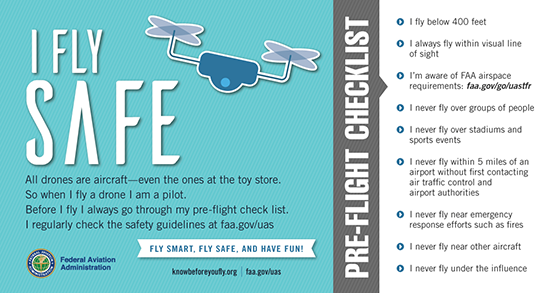Holiday Drone Safety - Safety
Holiday Drone Safety
NOTE: The information on this page is only for the recreation use of personally own Drones. Personally owned drones may not be flown at NPS without permission from Aviation Safety.
An unmanned aircraft system (UAS), sometimes called a drone, is an aircraft without a human pilot onboard – instead, the UAS is controlled from an operator on the ground.
When you fly a drone in the United States, it is your responsibility to understand and abide by the rules.
If you’re one of the lucky people who gets a drone as a holiday present, the Federal Aviation Administration wants you to know how to fly it safely. The agency has released a new video reminding everyone of the rules and regulations that safe drone pilots must follow.
As the video shows, before you fly your drone outdoors, the first thing to do is register it at www.faa.gov/uas. If you’re going to operate according to the model aircraft rules, you’ll receive one identification number to apply to all your drones. Non-modelers must register each of their drones individually.
The video also stresses that whether you fly your drone for recreation or business, safety is everybody’s responsibility. And that means following the rules:
- Don’t fly over people and respect the privacy of anyone on the ground.
- Don’t fly near other aircraft or in restricted airspace, such as “No Drone Zones.”
The video also tells you how to get the FAA’s B4UFLY smartphone app that provides the latest information about airspace restrictions wherever you intend to fly your drone.
The bottom line: Safe flying is what smart drone pilots do.
Requirements for flying a UAS for fun:
Pilot Requirements: None
Aircraft Requirements: Must be registered online with FAA (registermyuas.faa.gov) if over 0.55 lbs but less than 55 lbs at takeoff (including payload). If you wish to fly with weight exceeding 55 lbs, the UAS must be registered through the FAA's paper-based process.
Location Requirements: 5 miles from airports without prior notification to airport and air traffic control
Operating Rules: Must ALWAYS yield right of way to manned aircraft. Must keep the aircraft in Sight (visual line-of-sight). Must follow community-based safety guidelines. Must follow community-based safety guidelines. Must notify airport and air traffic control tower before flying within 5 miles of an airport.
Legal or Regulatory Basis: Public Law 112-95, Section 336—Special Rule for Model Aircraft FAA Interpretation of the Special Rule for Model Aircraft.


